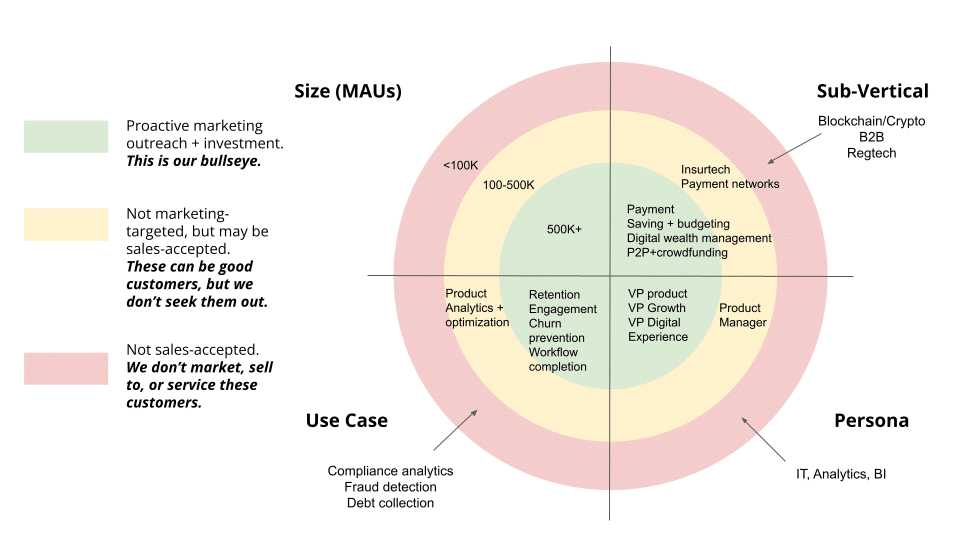It’s easy to imagine your ideal customer profile (ICP) like an exclusive club. Your prospects are either on the guest list, or they’re not. It’s that simple. Right?
We’ve written on choosing the right ICP as a strategic moat. However, a side effect of nailing your ICP with the right message and offering is “spillover demand”; folks outside of your target market knocking at your door. Sure, you may not want to invest time and resources into nurturing these folks, but that doesn’t mean you should just ignore them either.
The idea of your ICP as an “in or out” binary can be highly limiting. Here’s how to qualify and prepare for the wide spectrum of leads that will come your way.
A feature, not a bug
Maybe you’ve identified your ICP as, “the VP of Product at Fortune 1000 crowdfunding companies looking to reduce churn.” But obviously those folks are not the only ones who are going to see your messaging.
As you ramp up your demand gen efforts and go more “public” with your marketing (think: social media posts, SEO, speaking engagements at highly-trafficked events), your material is inevitably going to be seen by a wider audience. Even if you go with a highly targeted, account-based marketing approach, your prospects will forward your emails and refer you to their friends outside your ICP.
If you’re a highly niche MarTech platform selling to the midmarket, you’re going to get enterprise “looky loos” enticed by the potential of your product for some of their smaller internal teams. If you’re an AI-powered HR assistant selling to the uber-enterprise, you’re going to attract some SMBs looking to scale their workforce.
We once worked with a customer data platform (CDP) for the healthcare industry. They were specifically focused on HIPAA compliance and data interoperability, and their marketing reflected that targeting. But they saw strong interest among e-commerce and retail brands… not their sweet spot, but companies they could sell to and service profitably. There weren’t enough signals to indicate their original ICP was a poor fit, but does that mean they should tell those e-commerce and retail folks to (politely) take a hike?
Getting unexpected interest in your product doesn’t mean you should ditch the idea of your ICP – but it requires a more nuanced view of your market than a binary litmus test. As you get more granular with how you approach your ICP, you need a better way to conceptualize your most attractive prospects than just “yes” or “no” checkboxes. Once you’re outside of that ICP sweet-spot, how do you know when to still invest in a prospect, and when to cut loose? And just as importantly – how do you engage with your “spillover demand?”
How far off-target is too far?
One framework we’ve found helpful is the ICP map, or “concentric circles of goodness” (TM) (just kidding… still workshopping this one). The idea is simple: the bullseye is your ICP, and the value of customers falls off the further you get from the center.
Spend some time brainstorming the 4 dimensions of your ICP map. In addition to the ones shown below [company size (number of employees, revenue), sub-verticals, use cases and personas], classic examples include:
- Tech stack / architecture
- Geography
- Budget (e.g. ad spend, cloud spend)

This example shows what an actual ICP map looks like for a company selling mobile marketing automation software to fintechs.
Filling in the blanks on the ICP Map
In some ways, identifying who sits in the “Yellow Zone” and the “Red Zone” can be just as tricky as figuring out your ICP in the first place (Friendly Reminder: our ICP Worksheet is a great place to start if you haven’t yet identified your ideal customer).
Generally, it’s easiest to first define the “do not fly” zone (red on the ICP Map) by answering the question: who can’t we support?
- Incompatible tech stacks
- Geographic regions where we don’t offer service support
- Data volumes that are too high for our current scale
- Industries that require certifications (e.g. SOC 2) that we don’t have
If you need a reminder of who you absolutely can’t consider as a prospect, look no further than your churned customers and closed-lost deals.
From there, you can populate the “Yellow Zone.” Your “Yellow” customers will generally:
- close slower and at a lower rate than “Green” customers
- require more support resources than “Green” customers – including support that you can provide, but you may not yet have documented or implemented in your product
- be less likely to provide “superstar” reference logos for you
The key is to remember that “Yellow Zone” customers are those you still have a path to support, without completely re-inventing your wheel.
| Zone | Tactics | Examples of how we market and sell to them |
| Bullseye | This is where we focus all of our proactive marketing and sales effort. | The full marketing machine: ABM, conferences and events, webinars, content, etc. Faster sales cycle. Product champions. |
| Yellow Zone | These are prospects that we don’t target, but we can serve effectively – we need a process for qualifying them when they come inbound. | A one-pager or datasheet on how we may address their use case. Long, patient sales cycle. Not your best product advocates, but still supportable. |
| Red Zone | We avoid these customers like the plague. Prospects with data or security requirements we don’t support, geographic regions we can’t service, or a tech stack we don’t integrate with. | ❌🙅 |
The bottom line
The specific dimensions (vertical, size, etc.) of your ICP map will vary for your business. But the basic idea is the same:
Aim for the bullseye. Prepare for everything else.
Here’s our ICP worksheet to get you started and help you identify your ideal customer.








